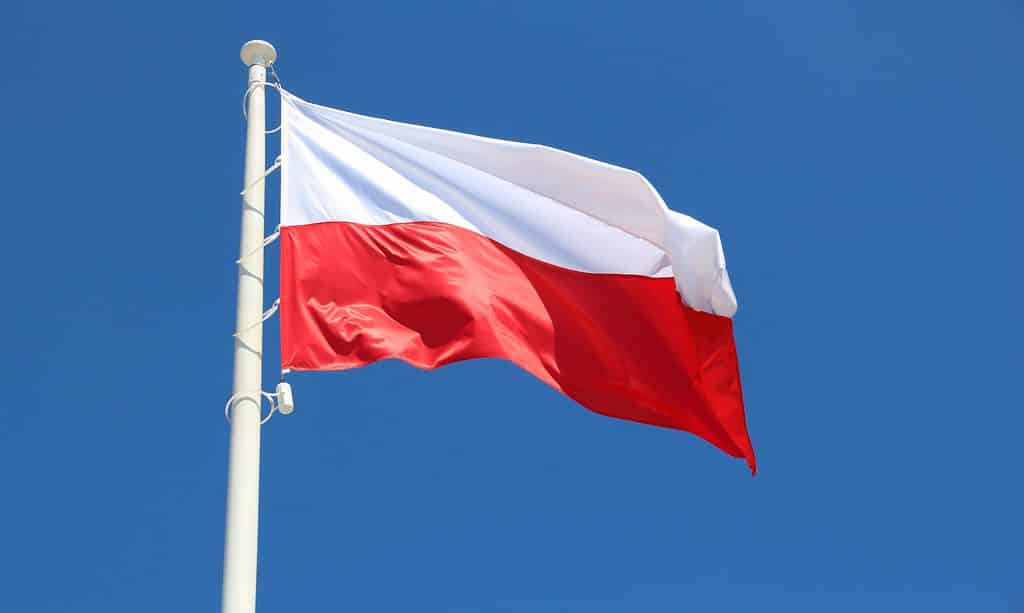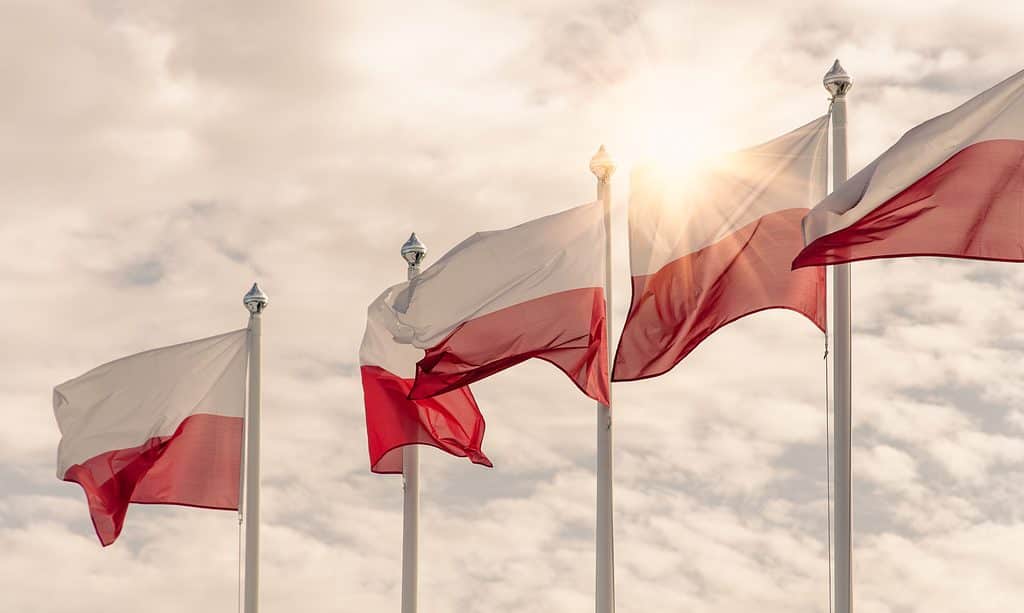National flags represent a nation’s traditional standing, political interests, and ancient roots. They symbolize a pure form of a country’s diverse and changing heritage. Although the Polish national flag is uncomplicated in design, it still inspires a certain amount of pride in many Polish people around the world. Poland’s flag, despite being simple, has a fascinating origin story. So how did the current Polish flag come to be? This article explores the history, meaning, and symbolism behind the flag of Poland and other facts. Let’s get started!
Introduction to the Polish Flag

The Polish flag has two horizontal stripes of equal width, with the top in white and the bottom in red.
©iStock.com/tupungato
With a height-to-width ratio of 5:8, the Polish flag has two horizontal stripes of equal width, with the top in white and the bottom in red. These colors are referred to as the national colors in the Polish constitution.
It might be astonishing to learn that there are two versions of the Polish flag. The red-and-white rectangle is the most common, which is always visible in Poland on holidays. However, the red-and-white flag with an eagle adorned with a crown is another design. It was first introduced in 1919 and only intended to be displayed at Polish diplomatic missions overseas. The coat of arms flag can also fly in airports, consulates, and commercial ships, as the applicable law permits.
Colors and Symbolism of the Polish Flag

The flag of Poland represents purity and love.
©iStock.com/Ewa Olek
Although Poland has been associated with these colors since the Middle Ages, white and red were only formally adopted as the nation’s colors in 1831. While the Polish flag’s primary colors have not changed in hundreds of years, their tones have. After the January Uprising in 1863, the predominant red hue switched from crimson to the amaranth tone before switching back in 1921. Later, vermilion took the place of the original crimson hue. On the other hand, the white stripe has a hint of silver.
The Polish flag’s white and red colors, which stand for purity and love, are reminiscent of Catholic ideals and symbolism. According to folklore, Poland’s first settlers took a white eagle attempting to land in front of a red sunset as a signal to make the territory their home (modern Gniezno).
National Coat of Arms
Poland’s coat of arms features a white eagle wearing a gold crown and has been used for hundreds of years. Lech, the fabled founder of Poland, was searching the area for a place to settle when, with the sun setting and a red sky in the distance, he spotted a big, soaring white eagle perched above its nest. Touched by the symbolic sight, he decided to develop a village there. The word “nest” (gniazdo in Polish) is where the name of Poland’s first capital, Gniezno, came from. The eagle later became an emblem of the state that grew out of that original settlement. With its outspread wings and protruding talons on a red shield, the Polish flag’s eagle has undergone several design changes and even lost its crown during the communist era. Following the demise of communism in 1989, the white eagle was triumphantly restored and reinstated in the official national flag.
History of the Polish Flag
European army used cockades, knots of colored ribbons hooked to the hat to identify their country of origin, throughout the 1800s and 1900s. During this time’s wars, Polish cockades were white and red.
Warriors like General Kosciusko and Poniatowski continued clipping their red and white cockades to their hats even after the military commission ordered soldiers to carry a metal cross representing Christ into combat.
As red and white in the military and governmental contexts continued to increase, civilians began to use the colors to celebrate. On May 3, 1792, in Warsaw, people marked the first anniversary of the Polish constitution by donning red and white for the first time in recorded history.
Poland served as a “puppet state” for France and Russia between 1807 and 1830. The need for a distinctive national icon in the military was decided during the November uprising against Russian rule in 1830. The Polish army then, once more, battled for its freedom from Russia, Prussia, and Austria while wearing red and white cockades.
The first time white and red flags were flown was on May 3, 1916, in Warsaw, during a nationalist presentation. The organizing committee instructed participants to place the white stripe above the red stripe to align the colors properly. Nevertheless, many protesters carried flags with a top red stripe. Nearly a year after Poland reclaimed its independence in November 1918, the Sejm formally unveiled a white-and-red bicolor as its flag on August 1, 1919.
The Polish National Flag Day
Flag Day, observed on May 2, is a national holiday in Poland that honors the raising of the red and white bicolor in Berlin following the Battle of Berlin. On May 2, 2004, the first Polish Flag Day was celebrated. It was created to enlighten Polish citizens about the origins and importance of their country’s symbols. Since 1990, when Polish Flag Day was established and the Constitution Day was reinstated, the flag has flown consistently for the first three days of May. Even though taking a day off on that day is customary, Flag Day is not a public holiday like May Day and Constitution Day.
Up Next:
3 Countries With Animals on Their Flags, and Their Meaning
The 10 Countries With Stars On Their Flags, and Their Meaning
29 Different Countries with Red, White, and Blue Flags
The Flag of Canada: History, Meaning, and Symbolism
The photo featured at the top of this post is © iStock.com/bndart
Sources
- (1970) https://www.expatspoland.com/polish-flag/#:~:text=Polish Flag Meaning,is present-day Gniezno
- , Available here: https://en.wikipedia.org/wiki/Flag_of_Poland
- , Available here: https://www.worldatlas.com/flags/poland
- , Available here: https://unacademy.com/content/upsc/study-material/general-awareness/history-and-facts-about-the-polish-flag/
Thank you for reading! Have some feedback for us? Contact the AZ Animals editorial team.






